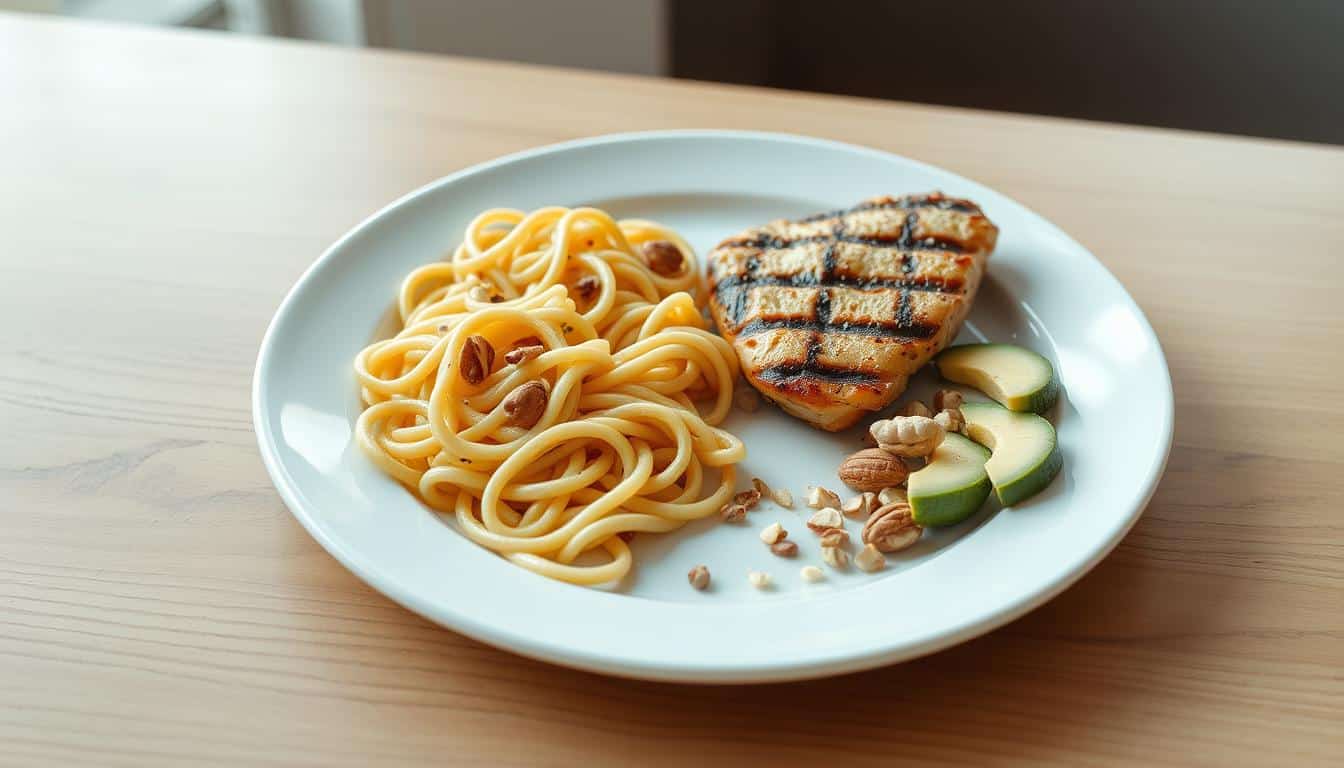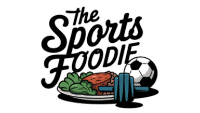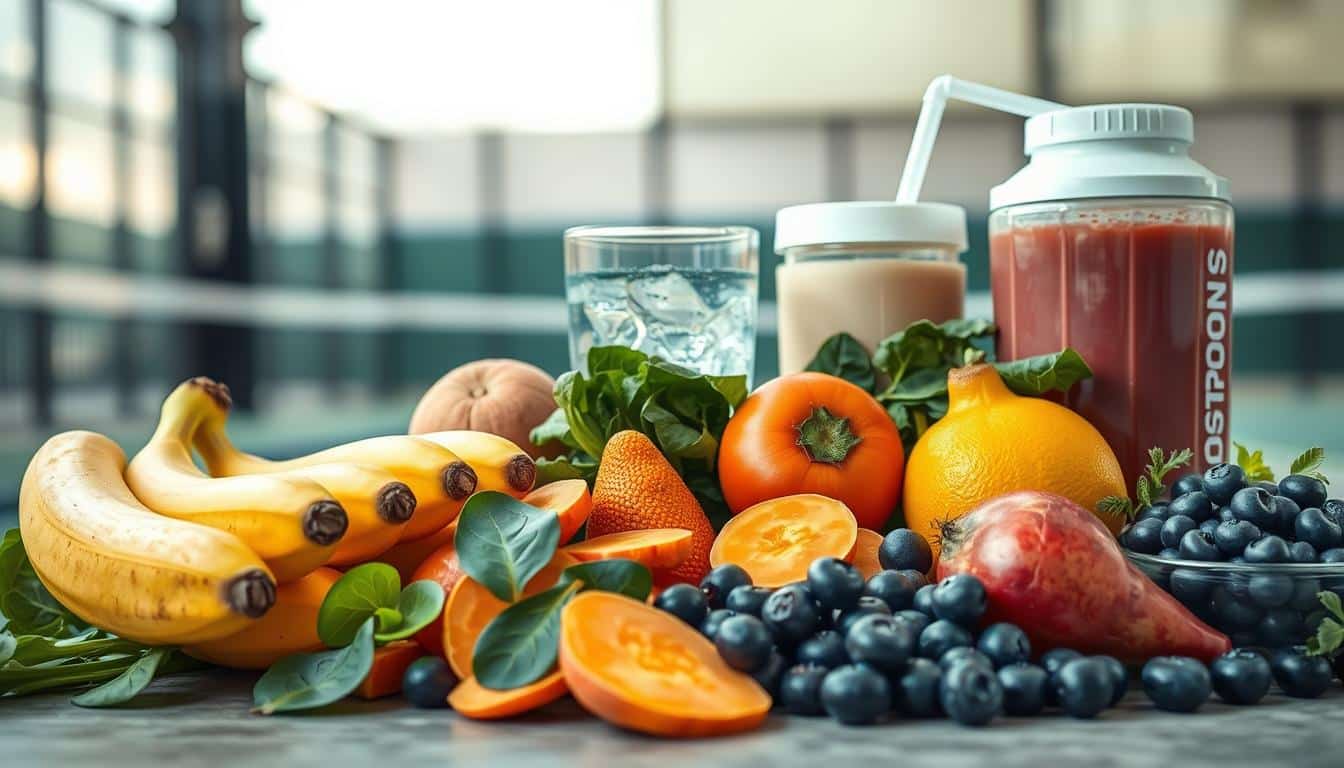Surprising fact: a 150-minute session can burn 1,100–1,700 calories, so small fueling moves matter.
You play to feel strong and sharp. I’ll show simple plans that give steady energy and clear rules you can use every day.
Glycogen can run low in 60–90 minutes. That means you need steady fuel during long play. Aim for 30–60 grams of carbs per hour after the first 90 minutes to keep energy up.
Hydration builds across the day, not just at changeovers. Wake up 2.5–3 hours before an early match so you can eat and digest. Cereal alone is low in protein and can cause a crash.
Eat within 15–60 minutes after play to speed recovery. Pack simple foods like bananas, nuts, and a bar so you can snack throughout match and keep focus.
Quick win: follow short, practical steps for training days, match days, and recovery so your body stays fueled and ready.
Why Tennis Players Need a Clear Nutrition Plan
A typical match forces your body to switch gears repeatedly. That stop-start pattern drains fuel fast and hurts decision making if you don’t plan ahead.
Energy demands of stop-start play
Pros can cover up to 10 miles in long matches. Glycogen stores hold about 300–600 g and can empty in 60–90 minutes at high intensity. That means your energy can drop mid-match unless you top up carbs and protein at the right time.

How food choices affect focus and mood
Poor breakfast choices, like low-protein cereal, often cause a mid-game crash. Food and liquids change mood and reaction speed. Better choices keep you calm and clear on court.
- Plan meals by time and intensity. Avoid playing while still digesting.
- Use protein plus carbs around sessions to steady effort level.
- Small changes, like adding protein at breakfast and spacing snacks, lift energy with little fuss.
A clear plan protects your energy, focus, and results. Stick to simple rules and you’ll play smarter every match.
Core Macros for Tennis: Carbs, Protein, and Fats
Simple macro targets remove guesswork and keep your energy steady. Follow clear ranges by session and week. This helps you train hard, play sharp, and recover fast.

Carb targets by day and during play
Set daily carbs at 5–7 g/kg on regular training days. Raise that to 7–10 g/kg during heavy training or a tournament week.
During any match or session over 90 minutes, add 30–60 g carbs per hour to keep glycogen from dipping.
Protein to support repair
Aim for about 1.6 g/kg per day. This helps muscles repair and speeds glycogen refill after sessions.
Choose eggs, poultry, fish, tofu, and legumes. They digest well and fit into busy schedules.
Healthy fats and vitamin absorption
Keep total fat under 2 g/kg per day. Use olive oil, nuts, seeds, and avocado.
These fats help absorb vitamins minerals (A, D, E, K) and support recovery and immune function.
- Quick guide: carbs 5–7 g/kg (training); 7–10 g/kg (tournament).
- Protein ~1.6 g/kg per day to repair muscles and aid recovery.
- Fats
| Macro | Daily Target | During Long Play | Example foods |
|---|---|---|---|
| Carbs | 5–7 g/kg (training) 7–10 g/kg (tournament) |
30–60 g/hr after 90 min | pasta, oats, rice, sweet potato |
| Protein | ~1.6 g/kg per day | Include after sessions | eggs, poultry, fish, tofu, legumes |
| Fat | <2 g/kg per day | Keep moderate | olive oil, nuts, seeds, avocado |
This macro setup gives tennis players a simple fuel map. Use foods you like so you can stick with the plan and keep energy levels steady across training, match, and recovery days.
Match-Day Timing: What to Eat and When
Match day runs on a clock — plan meals so energy peaks at the first serve.
Eat a main pre-match meal 2–3 hours before your match. Wake 2.5–3 hours early for very early starts so you can eat, drink, and warm up without rush.
Pick high-carb, moderate-protein, and low-fat options. Good examples are pasta with chicken and vegetables or a whole-grain turkey sandwich. Keep fat low so digestion stays smooth and energy feels steady.
Have a small snack 30–60 minutes before play. A banana or a low-fat bar tops off stores without weighing you down. Sip fluids with the snack so carbs absorb well in that last hour.
If play runs beyond 90 minutes, aim for 30–60 g carbs each hour to prevent an energy dip. For back-to-back matches, eat lighter at the break and snack at changeovers throughout match recovery.
| Timing | Window | What to eat (example) | Carb goal |
|---|---|---|---|
| Pre-match main | 2–3 hours before | Pasta + chicken, veggies | Moderate carbs |
| Pre-match snack | 30–60 minutes before | Banana or low-fat bar | Small top-up |
| During long play | Every hour after 90 min | Sports gel, banana pieces | 30–60 g/hr |
| Between matches | Breaks under 2 hours | Small sandwiches, fruit, bars | Light, frequent carbs |
Hydration and Electrolytes for On-Court Performance
Good fluid habits are built across days, not fixed to the match schedule. Start steady sipping so your body arrives ready and you don’t chase water in the first games.
Hydrate across days
Use a daily baseline higher than the NHS 1.2 liters per day if you train. Sip water throughout day and include electrolyte drinks on longer sessions.
Check simple cues: light urine color and stable pre-play weight. If you lose 1 kg during play, you lost about 1 liter of sweat.
Changeover volumes by temperature
In mild conditions (up to 27°C), aim for about 200 ml with electrolytes each changeover. In heat above 27°C, raise that to about 400 ml each changeover.
Space drinks across the minutes between games to avoid gut stress. Keep a bottle within reach so you sip, not gulp.
Electrolytes to support muscles
Add sodium, potassium, and magnesium to help fluid uptake and cut cramp risk. Electrolytes also help steady energy on court and speed recovery after matches.
- Start early: build hydration across days so the player arrives prepared.
- Drink water and include electrolytes to support fluid balance and stable energy.
- Track levels with urine color and pre/post weights.
- Replace ≈1 L for every 1 kg lost after a session.
- Practice your plan during training so it’s automatic in the hottest hours.
| Condition | Changeover Volume | Notes |
|---|---|---|
| Mild (≤27°C) | ~200 ml | Electrolyte drink; sip each changeover |
| Hot (>27°C) | ~400 ml | Higher sweat rates; replace more often |
| Post-match | Replace 1 L per 1 kg lost | Use water + electrolytes to restore balance |
Recovery Made Simple: The First 15-60 Minutes After Play
The first 15–60 minutes after play are your best chance to top up fuel and start repair. Hit the sweet spot in the first 15 minutes if you can, but any time inside the hour helps.
Carb-to-protein balance to refuel fast
Aim for roughly 50 g carbs and 30 g protein in your first serving. That mix restocks glycogen and delivers amino acids to tired muscles.
If you aren’t hungry, grab a shake immediately. Liquids move into the bloodstream fast and spare the gut.
Easy options: shakes, bars, and simple meals
| Option | Serving | When |
|---|---|---|
| Recovery shake | 30 g protein + 50 g carbs (milk or water) | 0–15 minutes post-match |
| Energy bar | One bar (~40–50 g carbs, 10–20 g protein) | If appetite low; follow with meal |
| Small meal | Sandwich + fruit (40–60 g carbs, 20–30 g protein) | 15–60 minutes once stomach settles |
- Include fluids with electrolytes to help move nutrients into the body and restore sweat losses.
- Make this a repeatable part of rest and training days so energy and muscles recover before the next match.
- Log what works during a training week and repeat it throughout match weeks to keep results steady.
Best Foods for Tennis Players: Practical Picks
Simple, reliable foods let you focus on the match, not your energy levels. Below are practical, easy-to-find choices you can use on training days and match day.
High-energy carbs
Pasta, oats, brown rice, and sweet potatoes give steady carbs and sit well before playing. Quinoa and buckwheat add minerals and a bit of extra protein. Oats and whole-wheat options are great breakfast bases.
Complete proteins
Eggs, fish, poultry, tofu, and legumes cover essential amino acids and help recovery after sessions. Eggs are cheap and easy to prepare at home or on the go.
On-the-go fuel
Pack bananas for fast carbs and about 450 mg potassium. Carry an energy bar, a few gels, or chews for quick carbs during short changeovers. Nuts and seeds add healthy fats and steady energy between meals.
Supportive extras
Try beet juice before long play to boost blood flow and stamina. Use tart cherry juice after matches to help reduce muscle soreness. Add leafy greens and broccoli for the vitamins minerals that aid recovery.
| Item | Why it helps | When to use |
|---|---|---|
| Pasta, brown rice, sweet potato | Steady carbs, easy digestion | Pre-match main meal |
| Eggs, fish, tofu, legumes | Complete protein for repair | Post-session or main meals |
| Bananas, energy bar, gels | Quick carbs, potassium, fast uptake | Pre-match snack & changeovers |
| Nuts, seeds, beet & tart cherry juice | Healthy fats, nitrates, antioxidants | Between meals; pre/post long play |
Quick habit: keep choices simple and test one new example each week so you find what works best on court.
nutrition tips for tennis players You Can Use Today
A clear if-then plan makes fueling simple when practice or matches get long. Start with daily rules and tweak by session level. These are small moves you can use throughout day and match time.
Build a daily plan by session intensity
Set carbs at 5–7 g/kg on moderate training days. Raise to 7–10 g/kg on heavy or tournament weeks.
Keep protein near 1.6 g/kg per day to aid repair and quick recovery.
If a day is light, shrink portions so you stay lean and ready for the next block.
Snack smart during long matches
For any match beyond 90 minutes, plan 30–60 g carbs each hour throughout match to keep energy steady.
Put snacks where you can reach them fast—gels in a pocket or a bar on the bench.
- Time your pre-match meal: 2–3 hours before, with a small top-off 30–60 minutes before.
- Log how you feel at each time and fine-tune your tennis player diet over the season.
- Make one small change per week so the plan sticks and energy stays high.
| Goal | Target | When |
|---|---|---|
| Carbs (moderate) | 5–7 g/kg | Training days |
| Carbs (heavy) | 7–10 g/kg | Tournament weeks |
| Protein | ~1.6 g/kg/day | Daily across training |
Sample Daily Menus for Players in the United States
Simple daily menus make match day less stressful and keep energy steady. Use cheap, easy meals you can prep on a Sunday and repeat across the week.
- Breakfast — Oatmeal with berries and nuts, or scrambled eggs with whole-grain toast and a small fruit.
- Mid-morning snack — Yogurt or an energy bar to lift protein and carbs before training.
- Lunch — Grilled chicken with brown rice and veggies, or a tuna sandwich on whole-grain bread with a salad for vitamins minerals.
- Afternoon snack — Fruit plus a handful of nuts to hold energy before an evening match.
- Dinner — Grilled fish with sweet potato and broccoli, or lean beef stir-fry with mixed vegetables.
Hydration: sip water (~1.2 liters per day baseline) and add electrolytes around long training or matches. If you play late, have a small protein snack before bed to aid overnight repair.
| Meal | When | What | Why |
|---|---|---|---|
| Breakfast | 2–3 hours before | Oatmeal + berries or eggs + toast | Steady carbs and protein to start the day |
| Mid-morning | 1–2 hours after breakfast | Yogurt or bar | Top up protein and carbs before training |
| Lunch | Noon | Grilled chicken + brown rice or tuna sandwich | Balanced protein, carbs, and vitamins minerals |
| Dinner | Evening | Fish + sweet potato or beef stir-fry | Refuel glycogen and repair with protein |
Try this menu for a week and tweak portion sizes by session. If you want a deeper fueling guide, check that resource to refine amounts per day and per session.
Conclusion
Conclusion
Small, steady routines win long matches more often than one big change. Build a simple plate around carbs and protein. Add healthy fats and steady water with electrolytes to keep energy even.
Use the timing windows: a main meal 2–3 hours before, a small top-off 30–60 minutes prior, and a recovery serving 15–60 minutes after. Recovery drinks help when appetite is low. Caffeine (about 3 mg/kg) can help in matches over two hours, but test it in practice.
Track how you feel each hour and tweak portions across a tournament week. Keep a ready kit of snacks and fluids. You’ve got this — practice the plan and your energy, rest, and muscles will repay the effort.
Try plant-based options with this handy guide to plant-based recipes to vary meals during the week.


